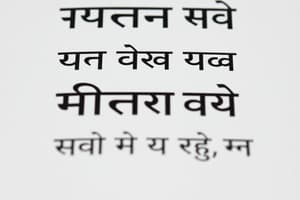Podcast
Questions and Answers
In which country is Hindi one of the official languages?
In which country is Hindi one of the official languages?
- Nepal
- India (correct)
- Pakistan
- Bangladesh
What script is primarily used to write Hindi?
What script is primarily used to write Hindi?
- Devanagari (correct)
- Cyrillic
- Greek
- Arabic
Which language family does Hindi belong to?
Which language family does Hindi belong to?
- Dravidian
- Austroasiatic
- Indo-European (correct)
- Sino-Tibetan
What is a common greeting in Hindi?
What is a common greeting in Hindi?
Approximately how many people speak Hindi as a first language?
Approximately how many people speak Hindi as a first language?
Flashcards
What is Hindi?
What is Hindi?
A language originating from the Indian subcontinent, part of the Indo-European language family.
Hindi Script
Hindi Script
Devanagari, written from left to right.
Where is Hindi spoken?
Where is Hindi spoken?
India. It is one of the official languages of the country.
Hindi influences
Hindi influences
Signup and view all the flashcards
Hindi Grammar
Hindi Grammar
Signup and view all the flashcards
Study Notes
- Hindi is an Indo-Aryan language.
- It is spoken chiefly in India.
- Modern Standard Hindi is one of the two official languages of the Government of India.
- It is an official language of 9 states and 3 union territories.
Origin and History
- Hindi's roots can be traced back to the ancient Indo-Aryan language, Sanskrit.
- The ancestor of modern Hindi is considered to be the Khariboli dialect.
- Khariboli emerged around the 13th century.
- By the 18th century, Khariboli gained prominence as a literary language.
- In the 19th century, British administrators promoted the use of Hindi in government and education.
- This promotion led to the standardization of the language and the development of a modern literature.
Modern Standard Hindi
- Modern Standard Hindi is a standardized and Sanskritized register of the Hindustani language.
- It finds its primary use across northern and central India
- It serves as both an official language and a lingua franca.
- The standardization of Hindi involved the conscious removal of Persian, Arabic and Turkic vocabulary.
- These words were replaced with words derived from Sanskrit.
Dialects
- Hindi exhibits considerable dialectal variation.
- Some dialects are mutually intelligible, while others differ significantly
- The dialects can be broadly classified into Western Hindi and Eastern Hindi.
- Western Hindi dialects include Khariboli, Braj Bhasha, Haryanvi, Bundeli, and Kannauji.
- Eastern Hindi dialects include Awadhi, Bagheli, and Chhattisgarhi.
- These dialects can be considered separate languages
- Khariboli forms the basis of Modern Standard Hindi.
- Braj Bhasha was a major literary language in the medieval period.
- Awadhi was used extensively by poets and writers during the Bhakti movement.
Geographical Distribution
- Hindi is spoken across a large swathe of northern and central India.
- Hindi is the official language of the states of:
- Bihar
- Chhattisgarh
- Haryana
- Himachal Pradesh
- Jharkhand
- Madhya Pradesh
- Rajasthan
- Uttar Pradesh
- Uttarakhand
- Hindi is the official language of the union territories of:
- Andaman and Nicobar Islands
- Dadra and Nagar Haveli and Daman and Diu
- Delhi.
- Significant Hindi-speaking populations are also found in:
- Maharashtra
- West Bengal
- Gujarat
- Karnataka
- Andhra Pradesh
Linguistic Features
- Hindi is an Indo-Aryan language.
- Hindi grammar shares many features with other Indo-Aryan languages such as:
- Urdu
- Punjabi
- Bengali
- Hindi is an analytic language.
- Hindi exhibits a subject-object-verb (SOV) word order.
- Hindi employs postpositions rather than prepositions.
- Hindi has a rich system of verb conjugations, marked for tense, aspect, mood, gender, and number.
- Nouns in Hindi are inflected for gender and number.
- Hindi distinguishes between direct and oblique cases.
- Hindi is characterized by the extensive use of compound verbs.
- The formation of compound verbs involves combining a main verb with an auxiliary verb.
- These combinations express nuances of aspect and modality.
- Hindi's phonology includes a number of retroflex consonants.
- These retroflex consonants distinguish it from many other languages.
- Hindi is written in the Devanagari script.
- The Devanagari script is an abugida.
- In an abugida, each consonant has an inherent vowel.
- Diacritics are used to represent other vowels or to indicate the absence of a vowel.
Vocabulary
- The vocabulary of Hindi is primarily derived from Sanskrit and Prakrit.
- Hindi has also borrowed words from Persian, Arabic, and English.
- The proportion of loanwords varies depending on the context and style of speech.
- Formal or literary Hindi tends to use more Sanskrit-derived words.
- Colloquial Hindi incorporates more Persian, Arabic, and English loanwords.
- The process of Sanskritization has led to the creation of new Hindi words.
- These new Hindi words are formed by combining Sanskrit roots and affixes.
- This process helps to expand the vocabulary of Hindi.
- It provides Hindi with terms to express modern concepts and ideas.
Relationship with Urdu
- Hindi and Urdu are often considered to be two registers of the same language, Hindustani.
- They share a common core vocabulary and grammar.
- The primary difference between Hindi and Urdu lies in their literary and formal vocabulary.
- Hindi draws heavily on Sanskrit.
- Urdu draws heavily on Persian and Arabic.
- Hindi is typically written in the Devanagari script.
- Urdu is typically written in the Perso-Arabic script.
- Despite these differences, speakers of Hindi and Urdu can generally understand each other in informal conversation.
- The divergence between Hindi and Urdu is more pronounced in formal contexts.
- Radio, television, education, and literature promote divergence.
Role in Indian Society
- Hindi plays a central role in Indian society and culture.
- It is used in a wide range of contexts, including:
- education
- media
- entertainment
- government
- Bollywood, the Hindi-language film industry, has a significant impact on Indian popular culture.
- Hindi is used in music, dance, and theater.
- Hindi is a medium through which cultural traditions and values are transmitted across generations.
- The promotion and propagation of Hindi has been a long-standing goal of the Indian government.
- Efforts have been made to increase the use of Hindi in government offices and public institutions.
- The promotion of Hindi has encountered resistance in some parts of India.
- Some people view the promotion of Hindi as a form of linguistic imperialism.
- They fear that it could marginalize regional languages and cultures.
- The debate over the role of Hindi in Indian society continues to be a sensitive and complex issue.
Studying That Suits You
Use AI to generate personalized quizzes and flashcards to suit your learning preferences.




